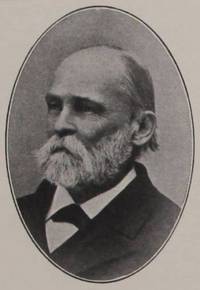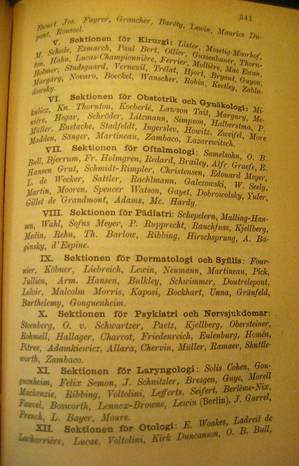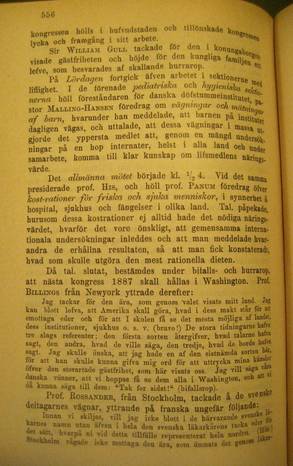Rasmus Malling-Hansen and the International Medical Congress in Copenhagen, 10-16 August 1884.
By Jørgen Malling Christensen
My research at the library of the Karolinska Institute, Stockholm, in June 2013, clarified some additional facts concerning the international medical congress of 1884, which became such an important event for Rasmus Malling-Hansen and his international reputation as a scientific researcher. The documentation was found in the Swedish medical journal “Eira”. “Eira” was, ever since its publication started in 1876, an important periodical for Swedish physicists. The chief editor was Erik Vilhelm Wretlind (1838-1905). All documentation in “Eira” is in Swedish language, and the following is an English summary of key aspects mentioned.
Participants, Program and Sections
The congress in Copenhagen was the eighth in the series of international medical congresses, held every fourth year. Around 1,400 medical doctors participated of which 350 from Denmark, 150 from Sweden, 100 from Norway and 800 from other nations. Among the participants were the élite of leading medical scientists, physicists and researchers, including personalities such as Rudolf Virchow, Louis Pasteur and Peter Panum. Pasteur and his family were staying at the best hotel in Denmark, D’Angleterre, where the wealthy brewer J.C. Jacobsen paid for a vast suite and put it at his disposal.
The congress had plenary meetings every day between 16.00 and 17:30. Most lectures and discussions took place in the 14 specialised sections; such sections had meetings every day from 10 to 12 and from 13 to 14. Official languages were French, English and German. All lectures and presentations had to be submitted in writing to the congress secretaries in advance. We know that Malling-Hansen had his presentation printed in German[1] and gave his presentation in that language as well. Only 20 minutes were allowed for each presentation, followed by a maximum of 10 minutes for discussions.
It was planned and billed as “a working congress” , and the programme was ambitious: 145 meetings planned, totalling 288 working hours.
The opening and closing session of the congress – and probably all of the plenary meetings – took place in the grand hall of the building for industrial expositions. The kings of Denmark and of Greece attended the opening session on Monday August 10, 1884.
The illustration from Eira (photo of pages 340 and 341) shows that Rasmus Malling-Hansen was scheduled to give his presentation in Section VIII, the section for paediatrics. However, it was later decided to combine the section of paediatrics with that of “Hygiene and public medicine”[2]. This made much sense, for obviously Malling-Hansen’s presentation was of great interest to specialists in both groups (see the footnote). In other words, Malling-Hansen’s presentation was not given in a plenary session (as has been previously contended).
According to the record – see page 556 of Eira – Malling-Hansen gave his presentation on the last day of the congress, i.e. on Saturday August 16. In the context of the section of paediatrics, his presentation was placed as the first one of 6 lectures during that session, and it was named: “Die normalen Gewichtsverhältnisse das spätere Kindesalter betreffend”. Mr Malling-Hansen, Copenhagen.
In the context of the section for hygiene and public medicine there were only three presentations scheduled for that day, and Malling-Hansen was placed as the first one. In French it was called: “L’accroissement normal du poids de l’enfant aprés la premiere enfance.”
Unfortunately, the very brief report in Eira only states that Malling-Hansen gave his presentation and (in my translation from Swedish) added: “In the combined sections for paediatrics and hygiene the principal of the Danish institute for the Deaf-Mute, pastor MALLING-HANSEN, gave a lecture about weighing and measurements of children, informing that the children of the institute are being weighed daily and stated that this type of group weighings constituted the best possible way – by establishing a multitude of similar investigations in other similar institutions, preferably in all countries and under close cooperation – to arrive at a clear knowledge concerning the nutritional value of different food stuffs. “
Albeit very brief, this comment conveys something very important for our understanding of Malling-Hansen’s ambitions and visions in terms of his ongoing research:
Malling-Hansen himself was puzzled by his own findings[3], and he wanted his methods replicated in many other institutions and in many other countries with climatic conditions different from those prevailing in Denmark. Personally, I believe that his main interest and focus in presenting his paper and lecture at the international medical congress was not at all to “show off” his amazing results and his skills as an “amateur”, yet skilled scientists in this field. No, his motivation and ambition was to raise interest in the findings so far obtained and to inspire other researchers, as well as principals of similar institutions the world over in order to have the methods replicated under different circumstances and find out whether the results obtained in Copenhagen would be found universally – or whether they were conditioned by local or specific geographical, climactic or other factors.
Malling-Hansen probably saw himself as the initiator of a major global research initiative, which would be undertaken under some kind of coordinated leadership and would lead to new understanding about the proper nourishment in public institutions.
In spite of the very short summary found in “Eira”, we know from other sources, that Malling-Hansen’s presentation was listened to with keen interest; we also know that the chairman of the session, professor Rauchfuss from St: Petersburg, expressed his considerable appreciation and gratitude in his summary of Malling-Hansen’s presentation. Dr Jacobi of New York also gave an appreciative and relevant comment. There are no records of any seriously critical remarks from any side, probably because the audience could not find any fault with his statistical methods and because his research was the most ambitious of its kind ever undertaken.
See Malling-Hansen’s presentation in full (in German) on our website as well as the comments by Dr Rauchfuss and by Dr Jacobi (text from the official record of the medical congress).
Malling-Hansen’s research methods and results were probably tested and replicated in many other countries in the following decades, but we have yet to follow up this line of research. We do know, however, that in particular Swedish doctors and scientists – Axel Key and Gustav Nylen for instance – were heavily influenced by him and carried forth his line of research.
Our website shows a copy of two pages of the official report from the congress. However, we are yet to find the complete work, entitled:
“Congres périodique internationale des sciences medicales. 8me session. Copenhague 1884”, published by Gyldendalske in four tomes, totalling 2,223 pages[4] and containing complete reports from the plenary sections and all 14 sections, as well as list of participants, daily programs etc.
[1] JMC: His presentation was, essentially, what is contained in his “Fragment II”, which we only know of in German language. See the entire text, and that of his presentation, on our website.
[2] JMC: The medical term “Hygiene” at the time was understood differently from today; it included hygiene in our modern understanding of the word, but it also encompassed important aspects such as physical exercise for health, healthy food for children and young people, fresh air, clean water, sunshine and everything else which was considered to have a bearing on the health of children, young people and urban population clusters in general.
[3] JMC : What puzzled him most was that he could not find any direct link between the quality and quantity of food on the one hand and the children’s weight and health, on the other hand. This led him to speculations about an external “X-factor”, emanating from the sun or from something else outside planet Earth.
[4] JMC: Information from “Eira” page 621.




